5 Ways to Manage Hip Pain
Your hip is one of your largest joints, and you use it constantly — to walk, climb stairs and stay balanced. So when you feel those first twinges of pain, it’s time to act.
Your first step? "See your primary care doctor," says Akira Yamamoto, M.D., a Sutter orthopedist in Mountain View. "Although rare, hip pain can be caused by infection or even cancer that has spread. You’ll want to rule out those possibilities right away."

Next, see an orthopedist to get a proper diagnosis. Hip pain can come from many sources — bursitis, poor running form, or even the wrong shoes. But the most common cause is osteoarthritis, a breakdown of cartilage in your hip joint that tends to happen with age.
Osteoarthritis affects more than 30 million adults in the U.S. and is especially common in the hips, knees and hands. Women are more likely than men to develop it, especially after age 50.
Try these steps to manage hip pain at home — and some effective treatments when home care isn’t enough.
1. Rest and Modify
High-impact activities like running, tennis or Zumba can make hip pain worse. Cut back on anything that pounds the joint and give yourself time to rest. “You have to cut out the activities that pound the hip joint,” Dr. Yamamoto says. “Give yourself a period of rest.”
2. Strengthen and Stretch
Low-impact exercises like bridges, planks and crunches can strengthen your core and support your hips. Activities like yoga, Pilates, swimming and walking help keep your hip joint flexible. If you need to lose weight, even a small drop can ease joint pressure.
3. Get Physical Therapy
A physical therapist can help you target the exact muscles that support your hip and teach you how to stretch safely. Ask your doctor if therapy is right for you.
4. Reduce Inflammation
Over-the-counter anti-inflammatory medications like ibuprofen can help, but talk to your doctor first. NSAIDs can be hard on your stomach, so take them with food. Alternating hot and cold packs on your hip may also help reduce swelling.
5. Time Your Surgery
When home care no longer helps, talk to your doctor about medical treatments. Corticosteroid injections may relieve pain for several months. And hip replacement surgery is both common and successful.
“When hip pain limits your daily activities — you avoid walks or have trouble climbing stairs — it’s time to seek care from an orthopedic surgeon,” says Dr. Yamamoto.
More than 300,000 hip replacements are performed in the U.S. each year. Most people report mild or no pain five years after surgery. But timing matters — people who wait until their mobility is severely limited are more likely to have lingering issues after surgery.
The Right Treatment for You
Your treatment depends on your age, activity level and goals. If you’re younger and active, physical therapy might be enough. If you’re older and struggling with daily tasks, surgery could be the best option.
If you just want to take short walks with your grandchildren, good shoes, stretching or even a cane might be all you need. But if you’re having trouble getting in and out of your car, climbing stairs or enjoying the activities you love, a new hip joint might be the answer.
Discover Similar Stories
Choose a topic below to read more stories like this one.
Move Better, Live Better
Whether it’s a new injury or long-term pain, our orthopedic teams are here to help you heal and get back to the life you love.





